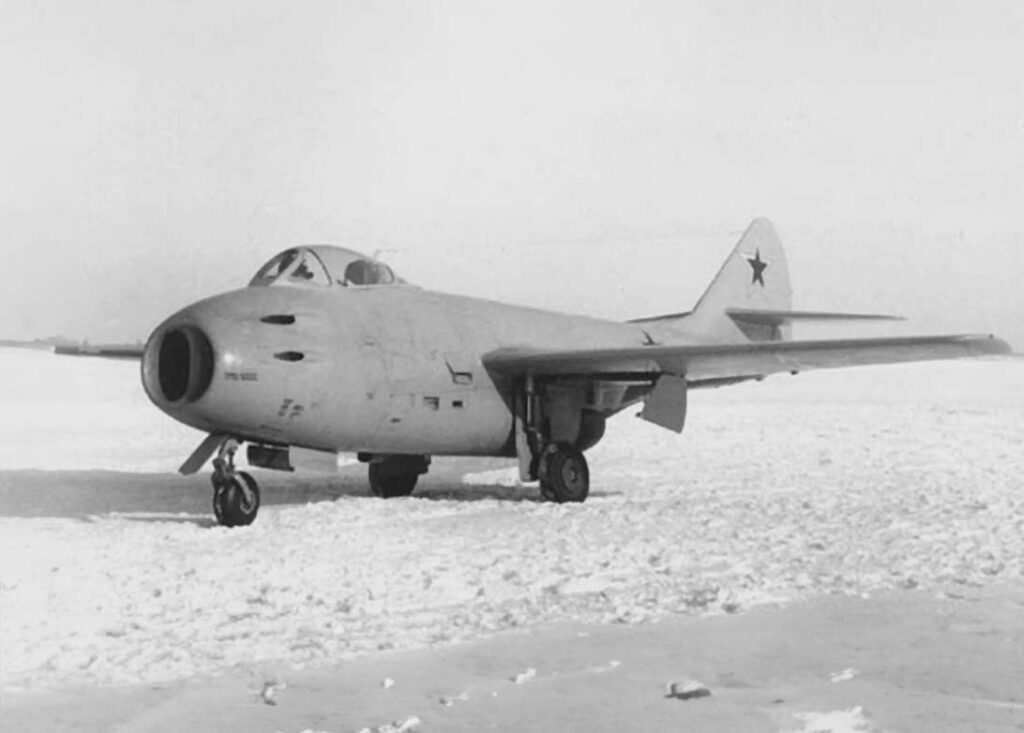The MiG-9, USSR’s first operational jet fighter, featured twin RD-20 engines and was designed for high-speed, high-altitude air superiority roles in the late 1940s.
The Mikoyan-Gurevich MiG-9 was a significant milestone in Soviet aviation, marking the USSR’s foray into operational jet fighters. This article details its development history, innovative design, performance parameters, military roles, and its impact on subsequent fighter designs.
The MiG-9 represents a pivotal chapter in the evolution of jet-powered fighter aircraft, embodying the technological advancements and strategic aspirations of the Soviet Union in the immediate post-World War II era.
History of the Development of the Mikoyan-Gurevich MiG-9
Developed in the aftermath of WWII, the MiG-9 was born out of the Soviet Union’s urgent need to counter the rapidly advancing jet technology of Western powers. Initiated by the Mikoyan-Gurevich design bureau, the program aimed to create a high-performance jet fighter that could maintain air superiority. The project was led by Artem Mikoyan and Mikhail Gurevich, launching in the mid-1940s.
The MiG-9, making its maiden flight on April 24, 1946, was a direct response to the challenges posed by the emerging Cold War. The aircraft was developed to capitalize on the jet propulsion technology and to provide the Soviet Air Force with a platform capable of engaging the latest Western aircraft.
Design of the Mikoyan-Gurevich MiG-9
The MiG-9’s design was revolutionary for its time. It featured a length of 32 feet 9 inches (10 meters) and a wingspan of 33 feet 1 inch (10.1 meters). The aircraft utilized a primarily metal construction, with some components made from wood and fabric, a common practice in the early jet era.
It was powered by two RD-20 turbojet engines, mounted in the fuselage’s rear with air intakes on the fuselage sides. This configuration offered advantages in terms of thrust and aerodynamic efficiency but also posed challenges in maintenance and engine cooling.
The MiG-9’s design was a significant advancement, incorporating swept wings and a tricycle landing gear, a departure from the tail-dragger configuration of WWII-era fighters. However, the aircraft faced issues with stability and engine reliability, typical of early jet fighters.

Performance of the Mikoyan-Gurevich MiG-9
The MiG-9 was powered by twin RD-20 engines, each producing 1,800 lbs of thrust. It could achieve a top speed of 540 mph (869 km/h), with a service ceiling of 42,650 feet (13,000 meters) and a range of 500 miles (805 km).
When compared to contemporaries like the American P-80 Shooting Star, the MiG-9 was competitive in terms of speed and altitude capabilities. However, it lagged in terms of range and maneuverability.
Military Use and Combat of the Mikoyan-Gurevich MiG-9
The MiG-9 was armed with one 37 mm Nudelman N-37 cannon and two 23 mm NS-23KM cannons, a formidable armament for air-to-air combat. Although it did not see extensive combat, it played a crucial role in the early Cold War period, patrolling Soviet airspace and deterring potential threats.
The MiG-9 was not widely exported, primarily serving in the Soviet Air Force. It was eventually replaced by more advanced designs like the MiG-15, which offered superior performance and reliability. The aircraft was decommissioned from active service in the early 1950s.
The Mikoyan-Gurevich MiG-9 was a foundational step in the development of Soviet jet fighters, paving the way for more advanced designs. While it had limitations, its contribution to the evolution of jet fighter technology in the Soviet Union was invaluable, marking the beginning of a new era in military aviation.
Back to the Fighter Jet section.